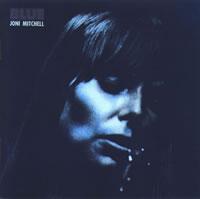Mitchell's Morose Masterpiece Meticulously Mastered
Joni Mitchell’s “road weary,” intensely personal adult confessional, released in 1971, shattered forever what appeared to be her carefully cultivated “hippie chick” image at a time when her star had ridden it to unimaginable heights on an almost vertical trajectory.
With Blue Mitchell emerged as a mature, introspective artist expressing a raw vulnerability that, ironically, communicated nothing less than utter fearlessness.
In the opinion of many, Blue set a standard for emotional intimacy and musical eloquence that’s not been equaled. It certainly was an unparalleled artistic leap from Ladies of the Canyon, exceptional as that album was.
It opens with a song about literal and figurative roads, bumpy ones, on paths striving for personal fulfillment in both career and love, neither of which appears to give Mitchell much satisfaction.
She follows with a song about “her old man,” said to be Graham Nash, and about not needing a marriage license to keep them “tied and true.” Yet the song, which should be affirming, is overwhelmed by musical and lyrical sadness. Mitchell is dependent upon her partner to keep her blues away. When he’s away they hit. How can a relationship survive such overdependence?
With “Little Green,” Mitchell’s songwriting becomes painfully personal in ways listeners back then could never have grasped, for it concerns the child she bore and put up for adoption when she was just 21 years old. The secret was revealed in 1988. You can read the entire fascinating, sometimes exhilarating, sometimes heartbreaking story (just like the song), “Joni Mitchell’s Secret,” on the MacLean’s magazine website at: http://tinyurl.com/2zdwv8.
“Carey” provides some joyful, nostalgic relief, recounting good times on the road, while “Blue” plunges the mood with an almost beautiful despair.
The longing for home in “California” seems almost trivial and comfortable, by comparison. The slinky, excited “This Flight Tonight” evokes both the anticipation of a reunion and the uncertainties, while “River,” the album’s melancholic Christmas setting masterpiece, expresses personal loss and a desperate longing to escape what should be savored success.
The album’s real end is the exquisite ex-lover/always a lover song “I Could Drink a Case of You,” with “The Last Time I Saw Richard” serving as the album’s denouement and featuring the unforgettable parting shot “Only a phase, these dark café days” before the final fade-out.
Blue is clearly Mitchell’s masterpiece (though others offer plenty of competition) and one of the defining albums of the post-hippie 1970’s; one that announces a generation reaching adulthood.
Sonically, the late, great engineer Henry Lewy produced a sonic masterpiece equal to the contents’ brilliance. Poor Lewy! There’s a version of Mitchell’s album Clouds where his name is spelled “Louie.” Here it’s spelled incorrectly again as “Lewey.”
The original, mastered by Bernie Grundman, who at the time this album was recorded at A&M Studios, ran the company’s cutting room, has an inexplicable “glitch” at the beginning of side one: the left channel doesn’t kick in for a split second, as if someone (Grundman?) forgot to flip a switch. How this made it through to the final pressing is a question I mean to ask Bernie next time I see him.
The original pressing came with a blue inner sleeve and a fine linen-like “crosshatch”paper cover. The pre “w corporate logo original label has “stereo” in black block letters and an orangey, not mustard color. If you look carefully on the “dead wax” area, you’ll see a tiny “BG” (Bernie Grundman) scribed there.
There’s much to be said for the original. It didn’t become an audiophile standard for nothing with its clean, natural vocal recording and harmonically accurate and texturally delicate piano sound. You can feel Mitchell’s feet working the pedals and sense here movement around the microphone. It takes you back 30 plus years into the studio and makes it come alive with every play.
That said, the reissue has far greater presence and physicality and is more immediate, dynamic, detailed and especially transparent. To their credit, Gray and Hoffman didn’t try to mess with the original’s intent. They’ve remained true to it while improving upon it in every way.
Highest recommendation, and a most highly anticipated reissue that lives up to every high expection. Yet at the same time if you find a clean original at a reasonable price, don’t hesitate, it’s got its own unique charms. Congratulations to all involved in the AAA vinyl reissue of Joni Mitchell’s Blue




